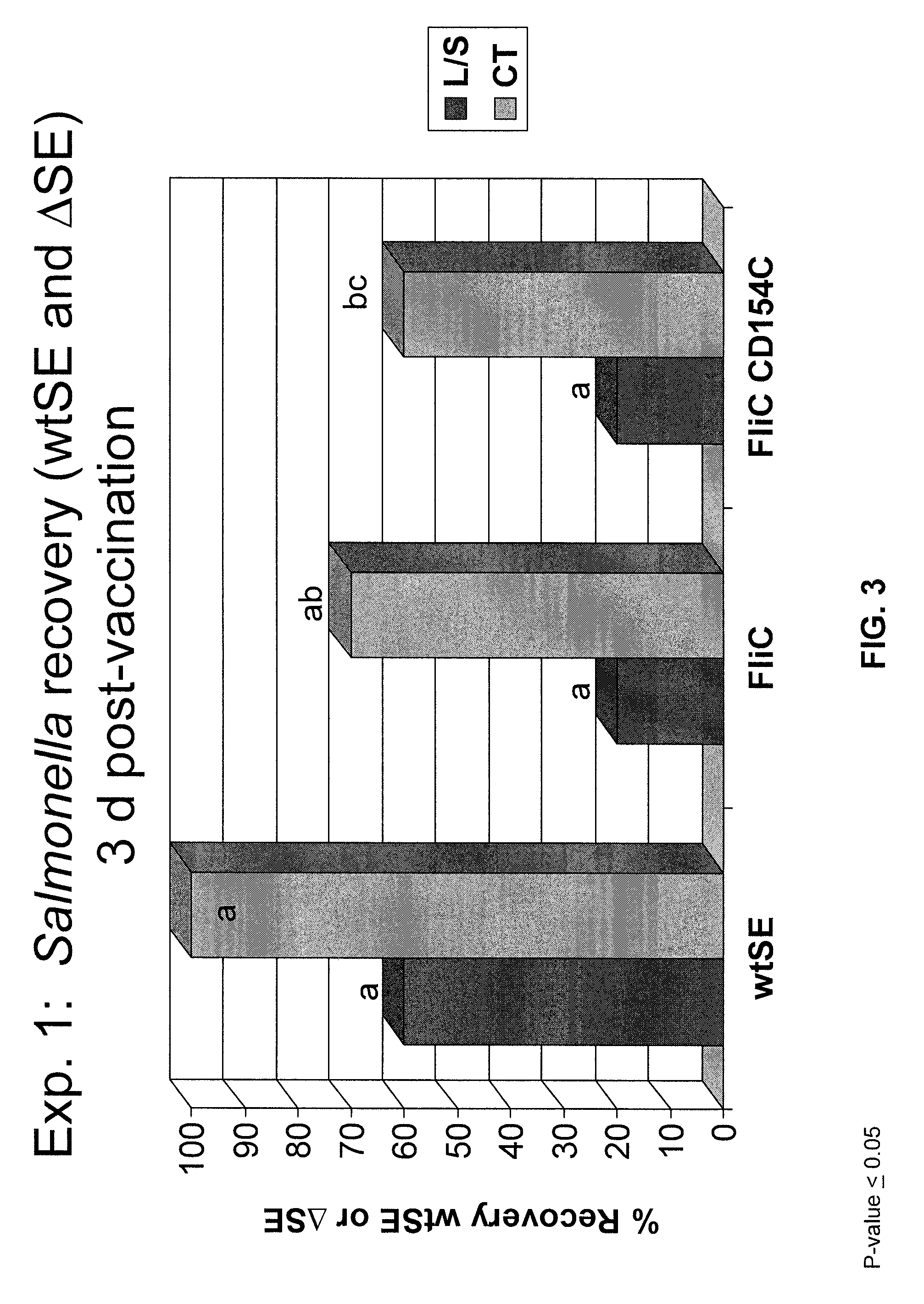Compositions and methods of enhancing immune responses to flagellated bacterium
a flagellated bacterium and immune response technology, applied in the field of compositions and methods of enhancing immune responses to flagellated bacterium, can solve the problems of 2% mortality and up to 20% morbidity, and achieve the effects of enhancing the immune response of the subject, and enhancing the immune response against flagellated bacterium
- Summary
- Abstract
- Description
- Claims
- Application Information
AI Technical Summary
Benefits of technology
Problems solved by technology
Method used
Image
Examples
example 1
Construction of fliC and fliC / CD154 Inserts
Strains and Culture Conditions
[0049]All plasmids were first maintained in TOP10 E. coli cells (Invitrogen, Carlsbad, Calif., USA) unless described otherwise. Salmonella enteritidis 13A was used for introduction of mutations. Salmonella enteritidis strain 13A was a field isolate available from USDA / APHIS / NVSL and deposited with the ATCC as deposit number PTA-7871. Bacteria carrying plasmid pKD46 were grown at 30° C. Other bacteria were grown at 37° C. Plasmid curing was conducted at 37° C.
[0050]Luria-Bertani (LB) media was used for routine growth of cells, and SOC media (Invitrogen, Carlsbad, Calif., USA) was used for phenotypic expression after electroporation. When appropriate, the following antibiotics were added to the media: ampicillin (Amp) at 100 μg / ml, kanamycin (Km) at 50 μg / ml, and chloramphenicol (Cm) at 25 μg / ml.
Plasmids
[0051]Plasmids pKD46, pKD13, and pBC-I-SceI were described previously (Datsenko and Wanner, PNAS 2000, 97:6640-...
example 2
Attenuation of fliC or fliC-CD154 Mutants / Inserts
[0061]Attenuation of SE13A was achieved by deletion mutation of the aroA gene and / or the htrA gene. Mutation of the aroA gene, a key gene in the chorismic acid pathway of bacteria, results in a severe metabolic deficiency which affects seven separate biochemical pathways. Mutation of the htrA gene reduces the cell's ability to withstand exposure to low and high temperatures, low pH, and oxidative and DNA damaging agents and reduces the bacteria's virulence.
[0062]To achieve deletion mutations in SE13A, the target gene sequence in the bacterial genome of S. enteritidis was replaced with the Km resistant gene sequence. This was completed using overlapping extension PCR and electroporation of the PCR products as described above. The Km resistance gene was targeted into the genomic region containing the genes of interest (aroA or htrA) by flanking the Km resistance gene with 200-300 base pairs of sequences homologous to the genes of intere...
example 3
Colonization of Chickens
[0063]Day-of-hatch chicks (40 per group) were inoculated with about 1×108 cfu of various Salmonella isolates or saline control. The Salmonella isolates included the following: wtSE represents the original field isolate of Salmonella enteritidis 13A (SE13A); fliC represents the double attenuated (i.e., aroA and htrA) wild type SE13A expressing fliC in the lamB loop (cell surface); fliC-CD154C represents the double attenuated wild type SE13A similarly expressing fliC and a chicken CD154 oligopeptide.
[0064]On days 3 and 21 post-vaccination the cecal tonsils (CT) and the liver and spleen (L / S) were harvested and bacterial recovery assessed by a standard colony forming unit (cfu) assay in 10 animals per group. The results are shown in FIG. 3 (Day 3) and FIG. 4 (Day 21) and are reported as Percent wtSE recovery as measured by the number of cfu recovered compared to the inoculum. No (zero) Salmonellae were recovered from either the non-challenged controls (control) ...
PUM
| Property | Measurement | Unit |
|---|---|---|
| Current | aaaaa | aaaaa |
| Immunogenicity | aaaaa | aaaaa |
Abstract
Description
Claims
Application Information
 Login to View More
Login to View More - R&D
- Intellectual Property
- Life Sciences
- Materials
- Tech Scout
- Unparalleled Data Quality
- Higher Quality Content
- 60% Fewer Hallucinations
Browse by: Latest US Patents, China's latest patents, Technical Efficacy Thesaurus, Application Domain, Technology Topic, Popular Technical Reports.
© 2025 PatSnap. All rights reserved.Legal|Privacy policy|Modern Slavery Act Transparency Statement|Sitemap|About US| Contact US: help@patsnap.com



